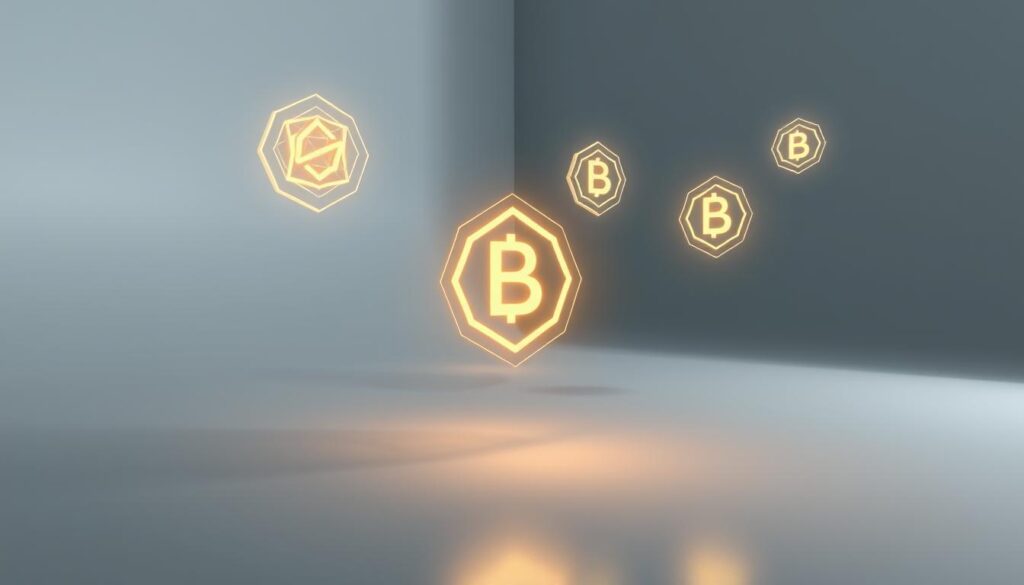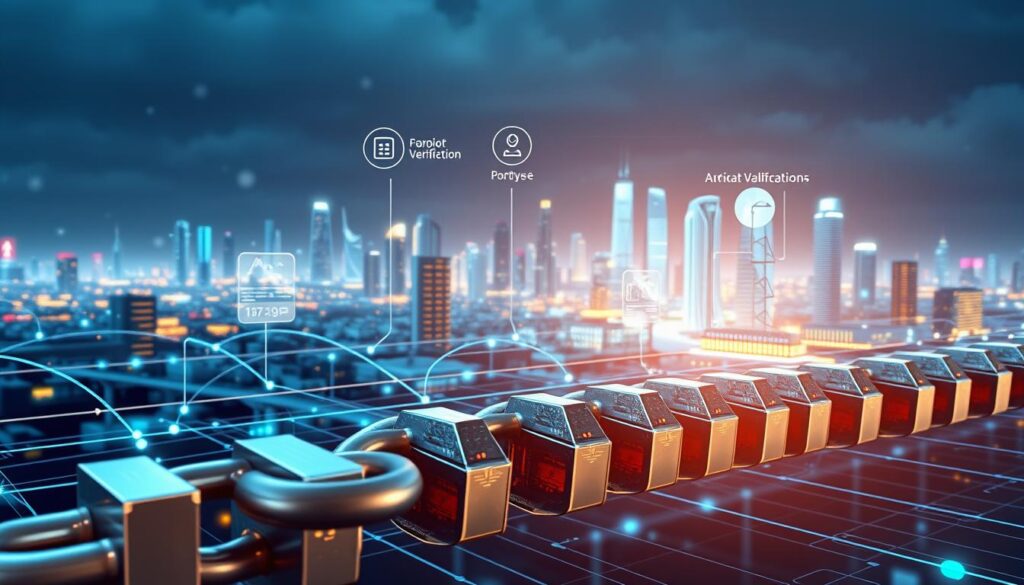Now Reading: Blockchain for Carbon Credit Trading Platforms Explained
- 01
Blockchain for Carbon Credit Trading Platforms Explained
Blockchain for Carbon Credit Trading Platforms Explained

Climate change presents one of humanity’s most urgent challenges, demanding innovative approaches to reduce greenhouse gas emissions. The global response has created massive environmental markets where companies can trade emission allowances.
These environmental markets represent a significant economic opportunity, valued at nearly $480 billion in 2023. Experts project robust annual growth exceeding 39% through 2030, driven by stricter government regulations worldwide.
Traditional environmental asset systems face several challenges including verification difficulties and transparency issues. New technological solutions are emerging to address these systemic problems effectively.
Distributed ledger technology brings inherent strengths like secure record-keeping and decentralized verification. These features directly improve how environmental assets are tracked and traded globally.
Key Takeaways
- Climate change demands innovative solutions for reducing greenhouse gas emissions
- Environmental markets represent a nearly $480 billion economic opportunity
- Traditional systems face transparency and verification challenges
- New technology offers improved tracking and trading capabilities
- Market growth exceeds 39% annually through 2030
- Government regulations worldwide drive market expansion
- Distributed systems create more accessible environmental markets
Introduction: The Intersection of Blockchain and Carbon Credits
Modern environmental markets are undergoing a technological revolution that promises greater transparency and efficiency. This transformation connects digital innovation with climate finance solutions.
Understanding the Basics of Carbon Credits
Carbon credits represent verified reductions in greenhouse gas emissions. Each unit equals one metric ton of carbon dioxide equivalent removed or avoided.
These instruments create financial incentives for emission reduction projects. Organizations use them to balance their environmental impact.
The system operates through both regulated compliance markets and voluntary participation. This dual approach expands opportunities for climate action.
Why Blockchain Matters in Environmental Markets
Distributed ledger technology addresses critical trust issues in traditional systems. It provides immutable records that prevent double counting.
Smart contracts automate verification processes significantly. This reduces administrative burdens and speeds up transactions.
The technology enables direct peer-to-peer trading without intermediaries. This creates more accessible and efficient environmental markets globally.
Understanding the Carbon Credit Market Landscape
The global landscape for environmental assets is built upon two primary types of initiatives. These categories define how value is created and measured within these dynamic carbon markets.
Market Growth and Trends
This sector reached a valuation of $479.41 billion in 2023. Analysts project a remarkable compound annual growth rate of 39.4% through 2030.
This explosive expansion is fueled by stricter regulations and corporate net-zero pledges. The market is segmented into removal/sequestration and avoidance/reduction projects.
Avoidance/reduction initiatives dominated, accounting for over 66% of revenue. These efforts focus on renewable energy and efficiency improvements to prevent emissions.
Removal projects actively pull carbon from the air using technology or natural solutions. Major organizations like Gold Standard and Verra certify these environmental credits.
Global Impact and the United States Perspective
The United States represents a significant force in both voluntary and compliance carbon markets. State-level programs, like California’s cap-and-trade, are leading the way.
American corporations are increasingly active buyers to meet sustainability goals. This creates a fertile ground for innovation within the North American market.
How Blockchain Technology Enhances Transparency and Efficiency
The integration of distributed ledger solutions into emission reduction markets addresses longstanding trust and verification challenges. This innovative approach creates a foundation for more reliable environmental asset management.
Digital ledger systems establish a new paradigm for tracking environmental contributions. They provide unprecedented visibility into each transaction’s history and validity.
Decentralization and Secure Record-Keeping
Distributed networks eliminate single points of failure in environmental markets. Multiple participants maintain identical copies of transaction records.
Advanced cryptographic protection ensures data integrity across the system. Every entry becomes permanently recorded and verifiable by authorized stakeholders.
| Feature | Traditional Systems | Blockchain Solutions |
|---|---|---|
| Transaction Verification | Manual processes requiring weeks | Automated near-instant validation |
| Record Security | Centralized databases vulnerable to tampering | Immutable distributed ledger protected by cryptography |
| Stakeholder Access | Limited visibility for participants | Transparent history available to authorized users |
| System Resilience | Single points of failure | Network distributed across multiple nodes |
Smart Contracts and Automated Compliance
Self-executing agreements streamline complex validation procedures. They automatically enforce predefined rules when conditions are met.
Automated systems reduce administrative burdens significantly. This technology accelerates settlement times from months to minutes.
Programmable contracts ensure consistent application of standards across all participants. They eliminate human error in compliance verification processes.
Exploring the Benefits for Carbon Trading Platforms
The adoption of distributed technology brings transformative advantages to emission reduction marketplaces worldwide. These innovative systems address long-standing challenges that have hindered environmental commodity exchanges.

Facilitating Secure Transactions
Digital ledger systems enable protected exchanges through advanced cryptographic protocols. Only authorized participants can initiate transfers while maintaining verifiable authenticity.
The technology creates an auditable trail documenting each environmental asset’s complete lifecycle. This includes project details, verification methods, and ownership history.
Comprehensive tracking ensures legitimacy and accurate environmental impact representation. Assets meet international standards like Verified Carbon Standard and Gold Standard.
Market access becomes more democratic, welcoming diverse participants regardless of size. Companies, governments, and individuals can engage in sustainability efforts effectively.
Counterparty risk decreases significantly as the system itself serves as neutral validator. Automation reduces costs, making participation economically viable for smaller projects.
Real-time settlement capabilities improve liquidity and capital efficiency. Enhanced transparency builds confidence by allowing quality verification before purchase.
Innovations in blockchain for carbon credit trading platforms
Recent technological breakthroughs are making environmental assets more accessible to diverse participants. Digital solutions are transforming how emission reduction instruments are managed and exchanged globally.
Streamlining Market Accessibility
Tokenization represents a fundamental shift in environmental commodity management. This process converts physical certificates into digital tokens that can be easily transferred and traded.
Fractional ownership capabilities dramatically lower investment thresholds. Smaller businesses can now purchase portions of carbon credits rather than whole units.
| Aspect | Traditional Approach | Innovative Solution |
|---|---|---|
| Minimum Investment | High cost for entire credit | Fractional ownership options |
| Geographic Reach | Regional limitations | Global trading capabilities |
| Settlement Time | Weeks or months | Near-instant transactions |
| Documentation | Complex paperwork | Automated digital records |
Digital marketplaces provide user-friendly interfaces for credit discovery and evaluation. These systems eliminate traditional barriers including high transaction costs and lengthy settlement periods.
Global access connects producers in developing nations with buyers worldwide. This creates more efficient environmental markets with enhanced liquidity and participation.
Deep Dive into Leading Projects: KlimaDAO, Toucan, and Moss
Several pioneering organizations have emerged as leaders in the tokenization of emission reduction instruments. These initiatives demonstrate different approaches to integrating digital solutions with environmental asset management.
KlimaDAO: Pioneering Blockchain in Carbon Markets
KlimaDAO operates with KLIMA tokens to accelerate carbon pricing through strategic interventions. The project purchases verified offsets from Verra’s registry and retires them permanently.
Each KLIMA token is backed by at least one Base Carbon Tonne (BCT). This creates an asset-backed cryptocurrency linked directly to carbon prices.
The initiative has retired 17.3 million tonnes of offsets. This represents approximately 2% of the entire voluntary market.
Toucan Protocol: Bridging Traditional and Crypto Markets
Toucan serves as critical infrastructure connecting traditional registries with digital networks. It transforms real-world credits into Tokenized CO2 (TCO2) tokens.
These semi-fungible tokens retain information about origin and project type. The Base Carbon Tonne pool powers various decentralized finance applications.
Moss: Tokenizing Forest Preservation Efforts
Moss takes a geographically focused approach with their MCO2 token. Each token represents one tonne of offset from Amazon rainforest preservation.
The Brazilian company ensures transparent, high-quality credits linked to conservation. Moss has expanded into NFT projects that fractionalize Amazon land parcels.
Proceeds fund 30-year preservation initiatives including patrol activities. These three initiatives showcase diverse strategies for environmental asset innovation.
Spotlight on Nori and DevvStream: Emerging Solutions
Two forward-thinking companies are demonstrating unique approaches to scaling carbon credit generation. Their innovative models address different challenges in the environmental asset space while leveraging technological advantages.
Nori’s Approach to Agricultural Carbon Removal
Nori operates a specialized marketplace focusing on agricultural carbon removal. The platform connects farmers practicing regenerative agriculture with buyers seeking high-quality removal credits.
Soil represents a massive natural carbon sink, containing three times more carbon than the atmosphere. Nori’s model reverses industrial agriculture’s carbon loss through verified soil sequestration projects.
Each Nori Carbon Removal Tonne represents one metric ton of CO₂ stored for ten years minimum. The company validated its approach through pilot programs before scaling operations.
Nori’s partnership with Bayer AG covers 400,000 acres of farmland. This $14.4 million agreement demonstrates significant corporate commitment to soil-based solutions.
DevvStream’s Carbon Streaming Model
DevvStream addresses financing challenges through a carbon streaming approach. The company provides upfront capital to projects in exchange for future credit production shares.
This model helps developers secure funding during critical early phases. DevvStream leverages its parent company’s proprietary ESG platform to place credits on-chain.
The company’s partnership with Xpansiv, the largest voluntary exchange, ensures market access and liquidity. This combination of traditional finance and digital innovation creates unique value.
Both companies show how targeted approaches can expand carbon credit supply effectively. Their distinct models contribute to a more diverse and resilient environmental market.
Tokenization of Carbon Credits: A Game Changer
Tokenization technology is fundamentally reshaping carbon markets by creating more accessible and liquid digital assets. This innovation converts physical environmental certificates into digital tokens that represent verified emission reductions.

The process begins when carbon credits are generated through certified projects and retired from traditional registries. Each digital token typically represents one metric ton of CO₂ equivalent that has been verified as reduced or removed.
This transformation addresses longstanding liquidity problems in environmental markets. Digital tokens can be traded instantly without the lengthy settlement periods of traditional systems.
| Feature | Traditional Credits | Tokenized Assets |
|---|---|---|
| Market Access | Limited to large institutions | Global 24/7 accessibility |
| Settlement Time | Weeks or months | Near-instant transactions |
| Minimum Investment | High entry barriers | Fractional ownership options |
| Verification Process | Manual documentation | Automated digital tracking |
Fractional ownership becomes possible through this digital transformation. Investors can purchase portions of carbon credits rather than whole units, dramatically lowering investment thresholds.
This democratization enables small businesses and individuals to participate in climate action. The rise of tokenized environmental assets creates unprecedented market accessibility.
Digital ledger technology ensures all transactions are transparent and traceable. Buyers can verify the environmental impact of their purchases with complete certainty from origination to retirement.
Smart Contracts and Automated Verification in Carbon Trading
Self-executing code is transforming the validation process for climate mitigation instruments. These digital agreements automatically execute when predefined conditions are met, revolutionizing environmental asset management.
Programmable contracts handle complex validation procedures with precision. They eliminate manual intervention while ensuring compliance with international standards.
Enhancing Trust with Immutable Records
Digital agreements create permanent, unchangeable audit trails for all activities. This immutability prevents fraudulent practices that have troubled traditional systems.
Real-time tracking capabilities provide complete visibility into each instrument’s lifecycle. Market participants can independently verify legitimacy and confirm proper retirement.
| Verification Aspect | Traditional Approach | Smart Contract Solution |
|---|---|---|
| Validation Time | Months of manual auditing | Near-instant automated checks |
| Cost Efficiency | High intermediary fees | 50-90% reduction in costs |
| Fraud Prevention | Vulnerable to manipulation | Immutable records prevent tampering |
| Transaction Speed | Weeks for settlement | Minutes for completion |
Automated retirement occurs immediately when instruments offset emissions. This prevents double counting and ensures accurate environmental impact reporting.
The technology integrates with IoT devices for real-time emission verification. This creates unprecedented transparency throughout the entire process.
The Role of Decentralized Finance (DeFi) in Carbon Markets
The standardization of environmental assets as ERC-20 tokens marks a critical step in their evolution. This transformation turns static certificates into dynamic financial instruments.
DeFi protocols operate without central authorities. They use smart contracts to provide services like lending and trading.

Integrating ERC-20 Tokens for Market Liquidity
Projects like Toucan Protocol have bridged substantial volumes into the Base Carbon Tonne (BCT) pool. These tokens use the widely adopted ERC-20 standard.
This compatibility allows seamless integration into existing DeFi applications. Market liquidity is dramatically enhanced as a result.
Decentralized exchanges provide transparent, real-time transactions. This increases access for a global pool of participants.
| Feature | Traditional Carbon Market | DeFi-Integrated Market |
|---|---|---|
| Liquidity Source | Limited to specialized exchanges | Global liquidity pools on DEXs |
| Settlement Time | Days or weeks | Minutes or seconds |
| Investment Minimum | High barrier to entry | Fractional ownership enabled |
| Price Discovery | Opaque pricing mechanisms | Transparent, algorithm-driven |
These tokens can serve as collateral for loans or earn yield in liquidity pools. This creates new financial utility for environmental credits.
The composability of DeFi enables sophisticated financial products. This innovation fundamentally changes how we interact with these vital environmental assets.
Blockchain’s Contribution to Minimizing Double Counting
The integrity of emission reduction markets depends heavily on preventing the same credit from being counted multiple times. This practice, known as double counting, represents a serious threat to environmental effectiveness.
Traditional systems have struggled with this challenge due to fragmented record-keeping across different jurisdictions. Manual processes often created delays that allowed duplicate claims to occur.
Distributed ledger technology provides a fundamental solution through its immutable record-keeping capabilities. Every transaction involving environmental assets becomes permanently recorded and verifiable.
Smart contracts automatically retire carbon credits once they offset emissions, removing them from circulation immediately. This real-time tracking ensures complete transparency throughout the entire lifecycle.
The technology creates a single source of truth that all participants can access independently. This prevents coordination problems that previously enabled double counting across different registries.
By ensuring each environmental instrument represents a unique reduction, these systems restore market confidence. This advancement strengthens the overall impact of climate finance initiatives globally.
How Blockchain Facilitates Global Access and Investment in Carbon Offsets
The democratization of emission reduction markets represents a fundamental shift in how climate action is financed. Digital ledger technology removes traditional barriers that limited participation to large institutions.
This innovation creates unprecedented access for diverse participants seeking environmental investment opportunities. The entire market becomes more inclusive and efficient.

Enabling Fractional Ownership
Tokenization allows carbon instruments to be divided into smaller units. This fractional approach dramatically lowers minimum investment requirements.
Instead of purchasing whole tonnes, buyers can acquire fractions of environmental offsets. This opens participation to individuals and small businesses previously excluded.
Expanding Opportunities for Small Investors
Digital marketplaces provide 24/7 global access without geographic restrictions. Small investors can now build diversified portfolios of environmental credits.
This supports specific project types aligned with personal values. Renewable energy and reforestation initiatives benefit from broader funding sources.
| Feature | Traditional System | Blockchain-Enabled System |
|---|---|---|
| Minimum Investment | $10,000+ required | Fractional purchases allowed |
| Geographic Access | Regional limitations | Global 24/7 participation |
| Participant Diversity | Large institutions only | All buyers welcome |
| Market Transparency | Limited visibility | Complete access to data |
The Impact of Blockchain on Regulatory Compliance
Navigating the complex regulatory landscape presents a significant hurdle for participants in environmental markets. Companies must meet evolving standards across different countries and certification frameworks.
Distributed ledger technology offers a powerful solution to these compliance challenges. It creates a permanent, auditable record of every activity related to environmental instruments.
Meeting International Standards
Global frameworks like the Verified Carbon Standard and the Paris Agreement’s Article 6 demand rigorous documentation. They require proof of origin, methodology, and verification for each unit.
This innovative technology automatically maintains comprehensive records of an instrument’s complete lifecycle. It tracks project details, verification reports, ownership transfers, and final retirement.
The transparent nature of this system provides regulators with unprecedented visibility. This reduces information asymmetry and improves oversight capabilities significantly.
| Compliance Aspect | Traditional Process | Blockchain-Enhanced Process |
|---|---|---|
| Documentation Verification | Manual review requiring weeks | Automated, immutable records |
| Cross-Border Accounting | Complex coordination between registries | Single source of truth for all parties |
| Regulatory Oversight | Limited access to transaction history | Complete transparency for authorities |
| Standard Adherence | Prone to human error | Smart contracts encode requirements |
Streamlining Carbon Credit Certification
Certification bodies can access comprehensive project information efficiently when data is stored on a distributed ledger. This includes verification data, monitoring reports, and audit results.
Smart contracts can automate compliance checking by encoding regulatory requirements directly into the system. They automatically verify that transactions meet applicable standards before execution.
The increasing involvement of governments in moderating voluntary markets benefits from this infrastructure. It provides the transparency and accountability necessary for effective public oversight.
Programs like the EU ETS can leverage this technology to enhance market efficiency. It reduces administrative costs and improves the accuracy of emissions tracking.
Driving Sustainability Efforts and Climate Change Mitigation
Society’s response to environmental degradation must evolve beyond symbolic gestures to deliver tangible atmospheric improvements. Digital systems enhance how we measure and verify ecological contributions.
Environmental markets create economic incentives for reducing harmful outputs. They channel capital toward solutions that address planetary warming.
Long-Term Environmental Impact
These innovative approaches transform how we value natural systems. The true cost of pollution becomes integrated into economic decisions.
Specific initiatives demonstrate this shift in action:
- Moss directs resources to Amazon rainforest preservation
- Nori focuses on soil carbon storage through regenerative farming
- Both approaches leverage nature’s own carbon sequestration capabilities
Soil represents one of Earth’s largest natural carbon sinks. It contains three times more carbon than the entire atmosphere.
These sustainability efforts ensure genuine environmental benefits. Transparency prevents empty claims while accelerating real progress against climate challenges.
The long-term impact extends beyond individual transactions. It establishes new frameworks for valuing ecological contributions across global economies.
Future Trends in Carbon Markets and Blockchain Innovations
As global climate initiatives intensify, the infrastructure supporting emission reduction instruments faces critical evolution. Environmental exchanges are poised for significant transformation through technological advancement.
Projected Market Growth and Future Projections
The environmental asset sector demonstrates remarkable expansion potential. Current valuation of nearly $480 billion could surpass $3 trillion by 2030.
This explosive development stems from tightening regulations and corporate sustainability commitments. Investor focus on ESG criteria further accelerates market growth.
Emerging Technologies and Adaptation Strategies
Digital ledger systems will evolve to address scalability and interoperability challenges. Layer 2 solutions will enhance transaction throughput for global-scale operations.
Integration with IoT sensors and AI will automate verification processes. These innovations will reduce costs while improving accuracy in environmental accounting.
The synergy between climate finance and digital infrastructure creates unprecedented opportunities. This convergence will drive sustainable development across global markets.
Conclusion
Digital innovation is fundamentally reshaping the landscape of emission reduction instruments, creating new pathways for climate action. This blockchain technology offers unprecedented transparency and efficiency for carbon markets worldwide.
The potential of these systems extends beyond technical improvements to reimagining environmental finance. Leading platforms demonstrate practical applications that are already delivering measurable results.
As adoption accelerates, these efforts will drive greater participation and trust in sustainability initiatives. The future of carbon credits appears significantly brighter with this technological integration.
Continued development efforts will determine how quickly these innovations achieve mainstream impact. The potential exists to fundamentally transform how humanity coordinates climate action.
FAQ
What are carbon offsets and how are they traded?
Carbon offsets are measurable reductions in greenhouse gas emissions used to compensate for emissions made elsewhere. They are traded in environmental markets, where companies or individuals buy them to meet sustainability goals. The market for these assets is growing rapidly.
How does blockchain technology improve the carbon credit market?
This technology enhances transparency and trust by creating an immutable, public ledger for all transactions. It helps prevent issues like double counting of credits and ensures the authenticity of each offset. Smart contracts can also automate verification and payment processes.
What is the problem of double counting in carbon markets?
Double counting occurs when the same emission reduction is claimed by more than one entity, undermining the integrity of climate efforts. It’s a significant challenge in traditional markets that distributed ledger technology can solve by providing a single, tamper-proof source of truth for credit ownership and retirement.
How does tokenization work for carbon credits?
Tokenization converts a carbon credit into a digital token on a blockchain. This process makes the asset more easily divisible and transferable. It allows for fractional ownership, increasing market accessibility for a wider range of investors and enhancing liquidity.
What role do smart contracts play in carbon trading platforms?
Smart contracts are self-executing contracts with terms directly written into code. On a trading platform, they automate crucial steps like verifying project data, transferring ownership upon payment, and permanently retiring credits. This automation reduces administrative costs and increases the speed of transactions.
Can blockchain help with regulatory compliance for carbon credits?
Yes, the immutable record-keeping of distributed ledger technology provides a verifiable audit trail for regulators. It can be designed to align with international standards, streamlining the certification process for carbon credit projects and making it easier for companies to prove compliance with environmental regulations.
What are some real-world examples of blockchain-based carbon platforms?
Several pioneering projects are active in this space. KlimaDAO focuses on building a liquid market for tokenized offsets. Toucan Protocol creates bridges between traditional carbon markets and decentralized finance. Moss.Earth tokenizes credits from Amazon rainforest preservation, while Nori focuses on carbon removal from agriculture.
How does blockchain make investing in carbon offsets more accessible?
By enabling fractional ownership through tokenization, this technology lowers the financial barrier to entry. Small investors can purchase portions of a credit, which was previously difficult in traditional markets. This opens up climate finance to a much broader audience, democratizing investment in sustainability.













